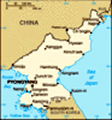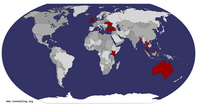COMING SOON HOUSE ADVERTISING ads_leader
Within the North Korean psyche, nothing is more despised than imperialist aggressors. Those evil, external forces that threaten to usurp the
Juche idea of self-reliance, and besmirch the Great Leader. Public enemy number one in this regard are the US - and they have held this title for the past sixty years, when they overtook Japan (and their imperialist efforts in the first half of the twentieth century) as the most despised nation. It was rare to hear the word “US” or “American” without the phrase “Imperialist Aggressors” spat out immediately after. This term was so common that I would automatically say the words “imperialist aggressors” in the rare instances when our hosts forgot to add this sobriquet to any reference to the US. This always received a nod of approval from our Guide and Official.
Given the siege mentality that the nation harbours, it should be no surprise that the military looms large within North Korean society. Our Guide informed us that the country adopts a
Songun (military first) policy, which takes precedence over economic policy. There are other countries that use the military-industrial complex as a means of development, but none would be as honest as the North
Koreans in espousing their pursuit of this ideal.
This military fixation sprouts from the division of Korea. The peninsula was united for centuries until the Second World War, when the Soviet Union and the US arbitrarily divided the country without any consideration for the consequences; similar to the French and British (more imperialists) divide of the Middle East in the 1920s and the subsequent problems that caused the region. Alas, the perils of dividing the spoils of war. The idea of a united Korea was a recurring them throughout this journey - monuments to it were constructed in the streets in Pyongyang and even the weather maps on the television news broadcasts showed Korea as one nation.
Our initial insight into North Korea’s military was provided by a visit to the Victorious Fatherland Liberation War Museum, and with a title like that, I knew we were in for something special. Dedicated to the memory of the Korean War, the use of the word “victory” was unusual considering the war ended in a stalemate. Obviously for the North Koreans, a draw is as good as a win.
The building was a sterile Soviet-style construction with oversized rooms and
layered the white and grey marble floors we kept seeing in public buildings around the country. Lights were turned on when we entered a room, only to be extinguished immediately after. In some areas, there was no illumination, so we walked through long and tall darkened corridors, as the whispers of local Koreans watching a Caucasian in the Museum echoed from the shadows. We sighted small groups of schoolchildren moving in orderly lines between the exhibits but they were rarely in clear view for long, so they appeared and reappeared like spectral forms wandering amongst the dim rooms.
It helped to suspend belief when touring this Museum. The guidebook to the Victorious Fatherland Liberation War Museum stated that the North Korean military achieved “Brilliant War Results Unprecedented in World History of War”, which included the highly improbable tale of villagers supporting a partially destroyed wooden bridge with their backs and hands to allow a full North Korean Army truck convoy loaded with men and machinery to pass overhead. We were regaled with similar tales at the Revolutionary Martyrs Cemetery later in the day, where an elderly lady who worked for the North Korean resistance bit off her own tongue
after being captured to prevent her from revealing too many secrets; I dared not ask our Guide whether she had been taught to write, otherwise the whole plan would have come to naught.
According to North Korea, the war was started by the US imperialists, though this is backed by little evidence. There are indications that a pre-emptive strike was being considered, and that is sufficient information to blame the Americans for starting the war. However, the southern forces were under the auspices of the United Nations, so whenever the subject of UN involvement was mentioned, we were told that the US cajoled the UN into being its puppet to fulfil their imperialist ambitions, in much the same way that the Americans invaded South Korea and forced their wicked capitalist ways upon them.
At one stage we saw an impressive 360 degree diorama of the “Taejon Liberation Battle” a key conflict which the North obviously won. We entered behind a group of schoolchildren eagerly watching the display, and our arrival prompted the teacher to shift the students to clear some seating space. The children languidly changed seats until they saw me stride towards them, at which time they

 The Great Leader surrounded by his adoring followers
The Great Leader surrounded by his adoring followers
The entrance to the Victorious Fatherland Liberation War Museum - Pyongyang, North Korea.literally jumped over each other to move away. Perhaps they thought I was a feared imperialist aggressor for they regarded me with suspicious eyes thereafter.
Most sobering was the North’s interpretation of the War’s four phases; the first was the unprovoked attack by the US imperialists and the counterattack by the North. The second phase was the troop surge that sent the North Korean army scuttling towards the Chinese border. The third was Chinese involvement that shifted the forces back to where they began - at the current border between the North and South. So what is the fourth phase? This has been ongoing for 60 years, as it is the preparation for the next battle. Given this definition, it was not a matter of
if there would be another conflict, but just
when it would occur.
This intimidating stance was backed by a visit to the USS Pueblo, a US “spy ship” that was captured off the North Korean coast in 1968, and is now displayed on the Taedong River, Pyongyang as one of the world’s largest trophies. In the video shown prior to touring the ship, the thickly accented voice announced that the US imperialist aggressors
are a dangerous nation that “must be stopped by force”. Enough said.
Militarily speaking, the most famous part of the country is the border with South Korea. We drove along a dual-lane carriageway that is supposed to be one of the major highways in the country, but for large portions of the journey, we were the only vehicle in sight. To establish the proper mood for my visit to the most heavily fortified border on the planet, I listened to appropriate mood music - Metallica, Nine Inch Nails, The Answer, and Grinspoon. As we proceeded closer, we noticed clusters of large concrete pylons adjacent to the highway. These could be destroyed if the imperialist aggressors invaded the country, thus depriving them of a rapid road access into Pyongyang.
Finally we arrived at the Demilitarized Zone (DMZ) in Panmunjom - the four kilometre section of land between two fortified lines of soldiers. The only indication we had arrived at our destination was the number of tour buses in wait. After a briefing by a military official our small bus led a convoy of mostly Chinese and European tourists to the site of where the negotiations that concluded the Korean
War took place. It was an interesting area with lots of memorabilia, and I caused some slight consternation amongst our hosts because I wanted to tarry here for longer than permitted. My non-appearance on the bus caused a hurried search for my whereabouts; this is not a country for the independently minded traveller.
We drove into the heart of the DMZ towards the Joint Security Area (JSA), and I was astonished to catch sight of working farms within this zone - imagine tending to your crops with one million soldiers at either side of your fields! We arrived at the large building that backed onto the JSA border and left the bus. I was eagerly waiting to see that great sight of North and South Korean guards standing only metres apart engaging in staring contests with each other. So you could imagine my disappointment when we were told that as a result of a recent agreement, if one country is hosting visitors, then the other will withdraw their guards from view. What an anticlimax!
All was not lost, as we entered one of the six buildings that straddle the border, namely the Military Armistice Commission Building which
is used for current negotiations between the two countries as it contained a meeting table wired with microphones. Funnily enough, it was possible to cross one of most tense borders in the world, just by walking around a table - if only all border crossings were this easy! The local guide was a military man sporting many honours, and his words were simultaneously translated by two guides - one in English, the other Chinese. So the room was a slightly chaotic babble of languages, whilst tall and stern looking military guards watched us with great intent. We could not linger for long so we retreated to the large North Korean building called Panmungak. We ascended the internal marble staircase for an elevated view of the area. We were free to take photos of anything; the only time we were allowed to photograph anywhere near a military installation.
Though I was underwhelmed by Panmunjom, greater things were in store later that day. We travelled to an observation post, which overlooks a place the North terms the “concrete wall”, an abhorrent construction that runs for 240 kilometres along the border. Though denied by the South, by peering through some conveniently placed
spyglasses, there did appear to be a solid construction of some note snaking through the countryside. Its design meant that it is not visible from the South, but was clearer from the North. We were informed that this illegal wall later inspired the Israelis to build a similar barrier between themselves and the Palestinian Territories. Such is the corrupting influence of imperialists around the world. There were no farms in this area due to the ridiculous number of landmines that lay in wait, and the expected tension lacking at Panmunjom was certainly evident here. When we espied a red South Korean helicopter patrolling the border, the Official expressed her scorn at this provocative move.
We left the observation post to a snappy salute from the soldiers on guard, to which I doffed my hat in return, and we again boarded our small bus for the final stop of the day - the visit to a secondary school in Kaesong. After driving around the nearly deserted streets where the only traffic were bicycles, pedestrians and the occasional bus (unusual for a city of 300,000 people), we arrived at the school. As would be expected, a picture of the Great Leader
and Dear Leader was found in every room, and when we entered a classroom filled with students undertaking extra classes, they all immediately stood, which took us aback somewhat. After a brief explanation of their studies, I thanked them by saying the only Korean word I knew “kamsa-hamneeda” (thank you) they all responded with a disciplined burst of sharp, short applause that appeared to be rehearsed.
Prior to leaving, I espied a series of numbers on the wall, and was informed that these figures represented the number of students admitted to the armed forces. Letters from some of these students exhorting the benefits of the military life were also displayed, along with images of two students who had been accorded the status of “Hero”. Another corridor was emblazoned with a military poster promoting the military ideal; imagine seeing that in your local school. This obsession with the military from such a young age will ensure that the
Songun policy will continue for at least another generation.
After delving into the subconscious of the country, it was apparent that North Korea is willing to pursue the military option to reunite the peninsula. I was sincerely hoping to discover that
much of the rhetoric we hear about the North Korean military psyche was stereotypical rubbish; but alas, it seems that this Western impression contains more than a few grains of truth.
Postscript: For my impressions of viewing the military situation from a Southern perspective in November 2011, please read Tirelessly Repelling the Red Menace.
COMING SOON HOUSE ADVERTISING ads_leader_blog_bottom
Tot: 0.4s; Tpl: 0.016s; cc: 62; qc: 204; dbt: 0.2397s; 1; m:domysql w:travelblog (10.17.0.13); sld: 1;
; mem: 1.8mb































liliram
liliram
Thank you, Shane
You sure did not make us wait that long. Thank you, Shane, for this blog. Many of us can only "travel" with you through your blogs. Pleased to appreciate Nokor adventures through your eyes!